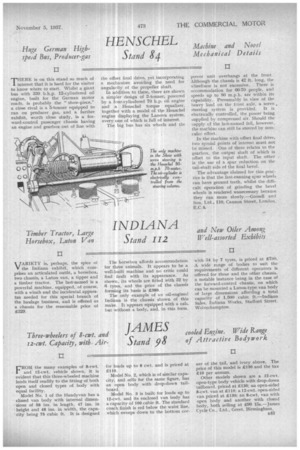HP;NSC1 - 11 - 4.;1, Stand 84 T HERE is on this stand so much
Page 51

If you've noticed an error in this article please click here to report it so we can fix it.
of interest that it is hard for the visitor to know where to start. Whilst a giant bus with 330 b.h.p. 12-cylindered oil engine, built for the German motor roads, is probably the "show-piece," a close rival is a 5-tonner equipped to run on producer gas, and a further exhibit, worth close study, is a forward-control passenger chassis having an engine and gearbox out of line with
the offset final drive, yet incorporating a mechanism avoiding the need for angularity of the propeller shaft.
In addition to these, there are shown a simpler design of 3-tonner, powered by a four-cylindered 70 h.p. oil engine and a Henschel torque equalizer, together with a model of the Henschel engine displaying the Lanova system, every one of which is full of interest.
The big bus has six wheels and the power unit overhangs at the front.
Although the chassis is 42 ft. long, the wheelbase is not excessive. There is accommodation for 60-70 people, and speeds up to 80 m.p.h. are within its capability. Presumably in view of the heavy load on the front axle, a servo .
steering system is provided. It is electrically controlled, the power being supplied by compressed air. Should the supply ef the last-named fail, however, the machine can still he steered by muscular effort.
In the machine with offset final drive, two special paints of interest must not be missed. One of these relates to the gearbox, the output shaft of which is offset to the input shaft. The other is the use of a spur reduction on the tail-shaft side of the final 'bevel.
The advantage claimed for this practice is that the fast-running spur wheels.
can have ground teeth, whilst the diffi cult operation of grinding the bevel wheels is rendered unnecessary because they run more slowly.—Gozsell and Son, Ltd., 110, Cannon Street, London. E.C.4.


















































































